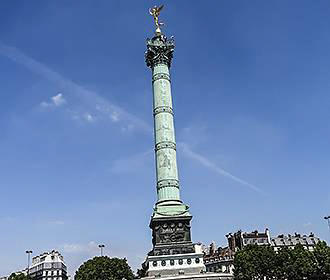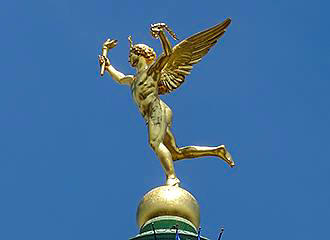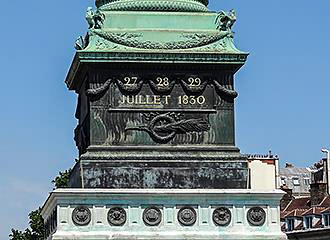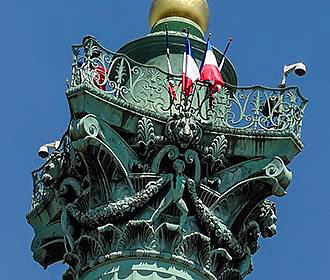Colonne de Juillet or July Column in Paris
The Colonne de Juillet, or July Column as it is known, is one of the monuments in Paris that you can visit today and it is located in the Place de la Bastille square, which has a rich history from the Bastille fortress to the Storming of the Bastille and the French Revolution.
History of the Colonne de Juillet
When the Bastille prison was demolished after the Storming of the Bastille that led to the French Revolution, the idea was to build a statue at the Place de la Bastille, and Pierre-Francois Palloy, who was a successful building contractor obtained the right to demolish the Bastille fortress and prison.
It was Pierre-Francois that really wanted a memorial built in the square and he laid the first stone from the demolished fort, but unfortunately this vision never materialised. Yet a lot of the stone was used to build the Pont de la Concorde bridge that spanned from Place de la Concorde on the right bank of the River Seine over to the Quai d’Orsay on the left bank.
Eventually there was a fountain built on the site in 1793, but by 1808 Napoleon Bonaparte I, had the vision of a great monument being constructed, and of all things he chose an elephant that people would be able to go up inside. He wanted this constructed out of bronze, but like many of his great ambitious projects in Paris such as the Arc de Triomphe that he never even saw finished, this particular monument in Paris was never produced.
Getting impatient, Napoleon had an elephant constructed that was only a cast made of wood and plaster that was erected in the square, but eventually was left to rot. In fact, you may have heard about this elephant, as it was one of the monuments depicted by the author Victor Hugo, in his novel Les Miserables.
Anyway, a few years later there was another French revolt, known as the 1830 Revolution and this was when King Charles X was removed from power and King Louis Philippe came to the throne and created a far more constitutional monarchy.
And so, in 1833, after this revolt, King Louis Philippe decided to have a monument constructed, just like the original plans by Pierre-Francois Palloy, and this was to commemorate the French revolution of 1789 with the Storming of the Bastille and also the Revolt of 1830, known as the Three Glorious Days, which also took place in the month of July.
So hence the name chosen was the Colonne de Juillet, which translates to July Column, and in 1831, the first stone was laid by King Louis Philippe who was known as the Citizen King. And in fact there was also a ceremony conducted at the Pantheon with a poem by Victor Hugo being sung.
Yet this monumental column was not inaugurated until the 28th July 1840, which was on the anniversary of the revolution, and the music composed for this occasion was by the composer and orchestra conductor Hector Berlioz. This musical composition was called the Grande Symphonie Funebre et Triomphale, and this was performed at the Place de la Bastille square with Hector Berlioz conducting.
About the Colonne de Juillet, July Column
The Colonne de Juillet at the Place de la Bastille square in Paris measures 47 metres in height and comprises 21 cast bronze drums that sits on a white marble base with ornamented bas reliefs, and was designed by the architect Jean-Antoine Alavoine under the orders of King Louis Philippe.
However, it was Joseph-Louis Duc who actually saw through the construction of this column, that has become one of the well known landmarks in Paris.
The July Column, as it is also known, has an internal spiral staircase, which originally allowed visitors to climb up inside this monumental column, however, unfortunately, they decided in order to preserve the structure for many years to come, this would no longer be possible.
But you can still admire the outside of the column, with its gilded statue on the top called the Genie de la Liberte, which translates to Spirit of Freedom, that was designed by the sculptor Augustin-Alexandre Dumont. And in fact, this emblem used to be printed onto the French 10 Franc coins.
The Colonne de Juillet is engraved with the names of Parisians who died during the revolution in 1830 and supposedly, many of the revolutionaries from this revolt are meant to be buried underneath the column at Place Vendome.
There is also a plaque at the bottom of the July Column on its base, which commemorates the glory of the French who armed themselves and fought during those three days of the revolt in the July of 1830.
Visiting the Colonne de Juillet
Located in the 11th Arrondissement of Paris getting to the July Column via public transport is easy, as there is a Metro station called the Bastille stop serving lines 1, 5 and 8 located directly at the Place de la Bastille. Additionally, a little further walk right by the River Seine, you have the Sully-Morland stop serving Metro Line 7.
However, the Bus Lines 24, 29, 57, 61, 63, 67, 69 76, 86, 87 and 91 along with the Noctilien Night Bus Service via Lines N01, N02, N11, N16, N31 and N144, will also get you close by, not forgetting sightseeing tour companies like Open Tour, but to discover all the Paris public transport with maps, timetables and plans you can see our dedicated page on how to get to Bastille.
Additionally, there is also a taxi rank located right on the square. Yet if you have your own vehicle, then you may be pleased to know that there is a public car park located on the Rue de Lyon, which is one of the main roads that takes you to the Colonne de Juillet and Place de la Bastille that runs alongside the Opera Bastille modern opera house in Paris.
Transport options
Paris Metro lines 1, 5, 7, 8
Bus lines 24, 29
Bus line 57
Bus lines 61, 63, 67, 69
Bus lines 72, 76, 77
Bus lines 86, 87
Bus lines 91, 96
Night bus lines N01, N02
Night bus lines N11, N16
Night bus lines N31, N34
Night bus line N144



